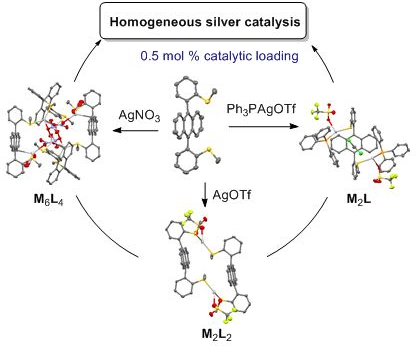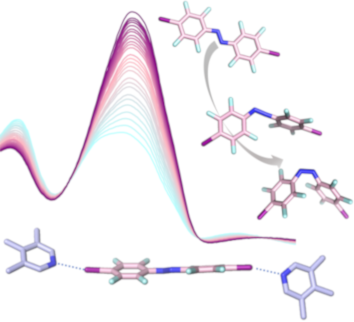Search results
Search for "anthracenes" in Full Text gives 19 result(s) in Beilstein Journal of Organic Chemistry.
Rotaxanes with integrated photoswitches: design principles, functional behavior, and emerging applications
Beilstein J. Org. Chem. 2025, 21, 2345–2366, doi:10.3762/bjoc.21.179

- composed of a dibenzo-24-crown-8 (DB24C8) and an axle with anthracenes as stoppers on both ends [28]. Light irradiation at 365 nm triggered the dimerization of the anthracenes allowing the conversion of the [2]rotaxane into a [2]catenane. Cycloreversion and formation of the rotaxane was achieved thermally
Extension of the π-system of monoaryl-substituted norbornadienes with acetylene bridges: influence on the photochemical conversion and storage of light energy
Beilstein J. Org. Chem. 2024, 20, 3061–3068, doi:10.3762/bjoc.20.254
- , such as absorption in the range of the solar spectrum, a high quantum yield of the photoreaction, long half-lives of the photoproducts, and a high energy storage density [7][8][12][13][14]. In this context, several different MOST systems have been explored, including, for example, anthracenes [15
Synthesis and characterization of 1,2,3,4-naphthalene and anthracene diimides
Beilstein J. Org. Chem. 2024, 20, 1767–1772, doi:10.3762/bjoc.20.155
- . Heating 5 with hexylamine or aniline in refluxing acetic acid successfully led to the formation of the targeted aromatic diimides bearing either N-hexyl (7-Hex) or N-phenyl (7-Ph) substitutions in good yields. The same strategy was employed to create the imide-capped anthracenes 8-Hex and 8-Ph
Novel route to enhance the thermo-optical performance of bicyclic diene photoswitches for solar thermal batteries
Beilstein J. Org. Chem. 2024, 20, 1053–1068, doi:10.3762/bjoc.20.93

- /vinylheptafulvene, azobenzenes, tetracarbonyl(fulvalene)diruthenium complexes, norbornadiene/quadricyclane (NBD/QC), anthracenes, etc. exhibit a few promising properties for MOST applications [10][12][13]. However, these photoswitching couples still lack one or more important properties required in MOST systems and
Complementarity of solution and solid state mechanochemical reaction conditions demonstrated by 1,2-debromination of tricyclic imides
Beilstein J. Org. Chem. 2022, 18, 746–753, doi:10.3762/bjoc.18.75
- its synthetic utility were investigated employing various dienes such as furan (18), 1,3-diphenylisobenzofuran (24) (DPIBF) and substituted anthracenes 31, 36 and 39 (Figure 3). Exclusive norbornene exo-π selectivity [24] was observed in all cycloadddition reactions. Selected five-membered dienes were
Site-selective reactions mediated by molecular containers
Beilstein J. Org. Chem. 2022, 18, 309–324, doi:10.3762/bjoc.18.35
- reports of supramolecular host-mediated Diels–Alder reactions of anthracenes, 9,10-adducts bridging the center rings of the anthracene frameworks were generally yielded [35][36][37], which resulted from the high localization of π-electron density at that sites [38]. Besides, these reactions required near
Recent advances in the syntheses of anthracene derivatives
Beilstein J. Org. Chem. 2021, 17, 2028–2050, doi:10.3762/bjoc.17.131
- years (2008–2020) and focuses on direct and indirect methods to construct anthracene and anthraquinone frameworks. Keywords: anthracenes; anthraquinones; Friedel–Crafts cyclization; intramolecular cyclization; metal-catalyzed; Introduction Anthracene is an important aromatic hydrocarbon consisting of
- has been reported over the years. The most familiar methods to obtain substituted anthracenes include Friedel–Crafts reactions [17], Elbs reaction [18], aromatic cyclodehydration [19][20], Bradsher-type reactions from diarylmethanes [21][22][23], and, more recently, metal-catalyzed reactions with
- -catalyzed reactions with alkynes Metal-catalyzed reactions with alkynes have gained attention in the last years and have provided new methodologies to prepare anthracene derivatives. In 2009, Miura and co-workers were the first to obtain substituted anthracenes selectively by homologations with
Self-assembled coordination thioether silver(I) macrocyclic complexes for homogeneous catalysis
Beilstein J. Org. Chem. 2019, 15, 2465–2472, doi:10.3762/bjoc.15.239

- distance between two anthracenes was ca. 6.31 Å and the dihedral angle between the anthracene core and its 9,10-aryl substituents was 89° and 104°, respectively. The head-to-tail macrocycle 1a adopted a V-shape (Figure 1b): the angle between the planes of the two anthracenes was 73.2° and the dihedral
Reversible switching of arylazopyrazole within a metal–organic cage
Beilstein J. Org. Chem. 2019, 15, 2398–2407, doi:10.3762/bjoc.15.232

- found to be stabilized in their zwitterionic form when confined to iron oxide nanoparticles [24]. Similarly, the ability of anthracenes to photodimerize greatly depends on the curvature of their “host” nanoparticle [25]. Despite these advances, we are still far from achieving the ease and elegance, with
Fluorinated azobenzenes as supramolecular halogen-bonding building blocks
Beilstein J. Org. Chem. 2019, 15, 2013–2019, doi:10.3762/bjoc.15.197

- , connected by C–H···F contacts. The azobenzenes A2 interact by lamellar 2D π-stacking, anthracene U1 interact predominantly by C–H···π interactions as both the solubilizing mesitylene group and the two perpendicular lutidine acceptors effectively prevent stacking of the anthracenes body (Supporting
Recent advances on the transition-metal-catalyzed synthesis of imidazopyridines: an updated coverage
Beilstein J. Org. Chem. 2019, 15, 1612–1704, doi:10.3762/bjoc.15.165

Enantioselective Diels–Alder reaction of anthracene by chiral tritylium catalysis
Beilstein J. Org. Chem. 2019, 15, 1304–1312, doi:10.3762/bjoc.15.129
- presence of strong Lewis acids [36]. We herein report the design and exploration of a new trityl carbocation that has a chiral weakly coordinating Fe(III)-based phosphate anion for the effective asymmetric catalysis in the Diels–Alder reaction of anthracenes. Results and Discussion In our previous work, we
- , could promote the Diels–Alder reaction with anthracenes and various unsaturated carbonyl compounds under mild conditions [13]. The use of latent carbocation catalysis with TP was examined in order to achieve enantioselective control. To our delight, TP catalyzed the asymmetric reaction affording
- of the ketoesters were well tolerated, giving the products in decent yields and high enantioselectivities. Unfortunately, no reaction was observed when an aliphatic substituted β,γ-unsaturated α-ketoester was used (data not shown). The Diels–Alder reaction of substituted anthracenes has been well
Nitration of 5,11-dihydroindolo[3,2-b]carbazoles and synthetic applications of their nitro-substituted derivatives
Beilstein J. Org. Chem. 2017, 13, 1396–1406, doi:10.3762/bjoc.13.136
- compounds 9a and 13a, respectively (Scheme 6). It is known that 9,10-anthraquinones can be converted into 9,10-unsubstituted anthracenes on reduction with zinc under basic or acidic conditions. A plausible mechanism for the discovered transformation can involve simultaneous reduction of both nitro groups in
Experimental and theoretical insights in the alkene–arene intramolecular π-stacking interaction
Beilstein J. Org. Chem. 2016, 12, 1616–1623, doi:10.3762/bjoc.12.158

- auxiliary. Results and Discussion The synthesis of acrylate derivatives 6a,b bearing CF3 and OMe substituents in the para position of the phenoxy group is depicted in Scheme 1. Levoglucosenone (1) was used as a dienophile to react with the corresponding 9-substituted anthracenes 2a,b, which are easily
Functionalization of anthracene: A selective route to brominated 1,4-anthraquinones
Beilstein J. Org. Chem. 2011, 7, 1036–1045, doi:10.3762/bjoc.7.118
- and 8 was developed, where base-mediated elimination yields the synthetically valuable 1-methoxy-3,9,10-tribromoanthracene (10) and 1-methoxy-2,9,10- tribromoanthracene (11), which are very useful precursors for the synthesis of many other substituted anthracenes due to the easy substitution of the
- a simple route to a range of highly functionalized and potentially useful polysubstituted anthracenes. Experimental General: Thin layer chromatography was carried out on Merck 0.255 mm silica gel F254 analytical aluminum plates and spots were visualized with UV fluorescence at 254 nm. Classic
Reversible intramolecular photocycloaddition of a bis(9-anthrylbutadienyl)paracyclophane – an inverse photochromic system. (Photoactive cyclophanes 5)
Beilstein J. Org. Chem. 2009, 5, No. 20, doi:10.3762/bjoc.5.20
- recovered by irradiation at 306 nm or by heating. This ‘inverse’ photochromic system has a potential for optical information storage, compound 4 being stable in visible light, at ambient temperature. Keywords: anthracenes; cyclophanes; inverse photochromism; photocycloaddition; Introduction Photochromism
- the molecule. This rules out symmetrical cycloadditions such as the 9,9′ : 10,10′ [4+4]reaction of anthracenes [11], whether combined or not with two cyclobutane-forming [2+2]additions. Dissymmetrical closures [11][12] such as 1,4 : 9′,10′ [4+4] or 1,4 : 2′,3′[4+2]cycloadditions (as well as rearranged
Highly brominated anthracenes as precursors for the convenient synthesis of 2,9,10-trisubstituted anthracene derivatives
Beilstein J. Org. Chem. 2008, 4, No. 50, doi:10.3762/bjoc.4.50
- fields, e.g., material chemistry [1][2][3][4], thermochromic or photochromic fields [5], and organic light-emitting devices [6][7][8][9][10][11][12][13][14]. Moreover, anthracenes have been used in optical, electronic, and magnetic switches, and combined with polymers, films, and crystals [15][16]. In
- polybromo-substituted anthracenes is restricted because reactivity towards bromine is reduced as bromination proceeds [34]. However, our study achieved efficient bromination without a catalyst under mild conditions. We have described an efficient and convenient synthesis of the hexabromide 3 and the
Synthesis of 2,3,6,7-tetrabromoanthracene
Beilstein J. Org. Chem. 2008, 4, No. 41, doi:10.3762/bjoc.4.41
- , electroluminescence) and several reviews have been published so far [1][2][3]. Anthracenes may be readily functionalized in positions 9 and 10 due to their exceptional reactivity. The outer rings, however, can not be functionalized easily. There are some anthracene compounds available with one or two substituents at
- involving brominated anthracenes [7][8][9][10][11][12], mainly using anthraquinones for the bromination at an outer position, but a synthesis of 2,3,6,7-tetrabromoanthracene is missing. In this paper, we report a convenient four step synthesis of 2,3,6,7-tetrabromoanthracene via a twofold Bergman
- cyclization. This tetrabromide constitutes an excellent precursor for 2,3,6,7-tetrasubstituted anthracenes due to the bromine groups and it is also a candidate precursor to 2,3,6,7,9,10-hexabromoanthracene because of the high reactivity of the 9,10-positions. In addition, new materials may also be accessible
Effect of transannular interaction on the redox- potentials in a series of bicyclic quinones
Beilstein J. Org. Chem. 2006, 2, No. 26, doi:10.1186/1860-5397-2-26
- starting compound. Despite the neglected orbital relaxation that immediately follows the reduction, such correlations have proved to be an efficient tool for prediction of redox-potentials of anthracyclines [5], substituted anthracenes [6], and oligothiophenes [7]. For all chemical species, the






























































































































































































































































































































































































































